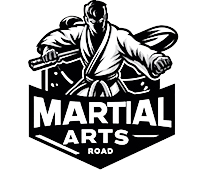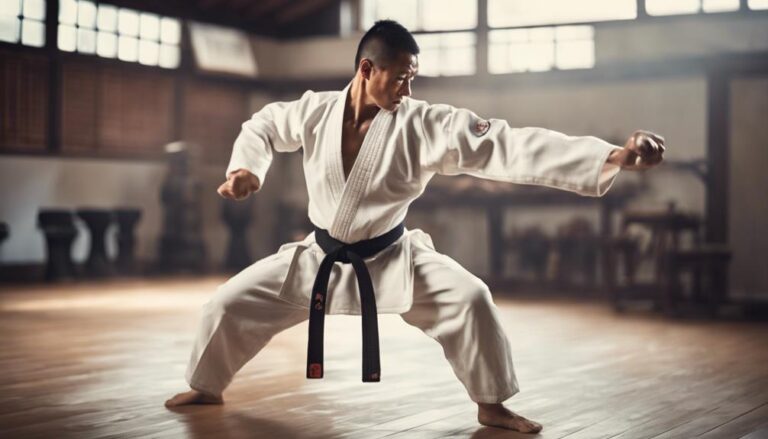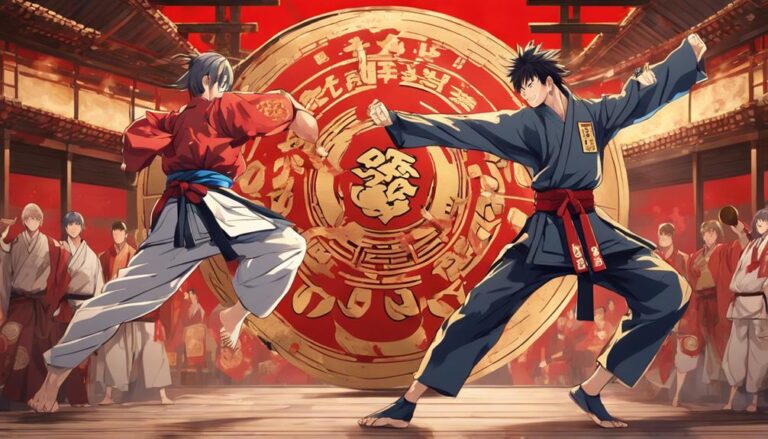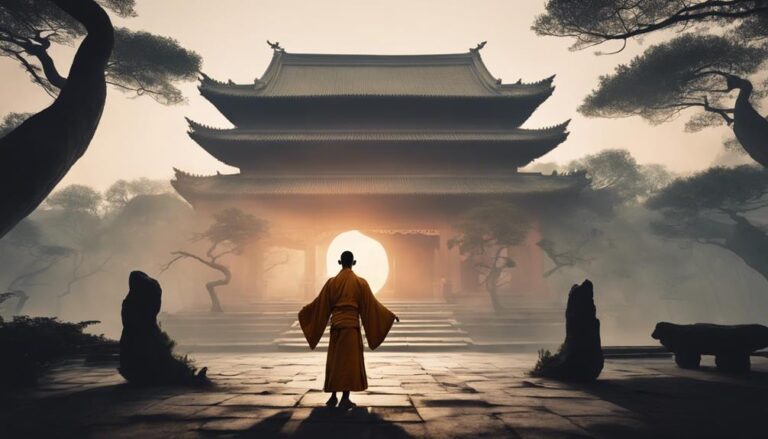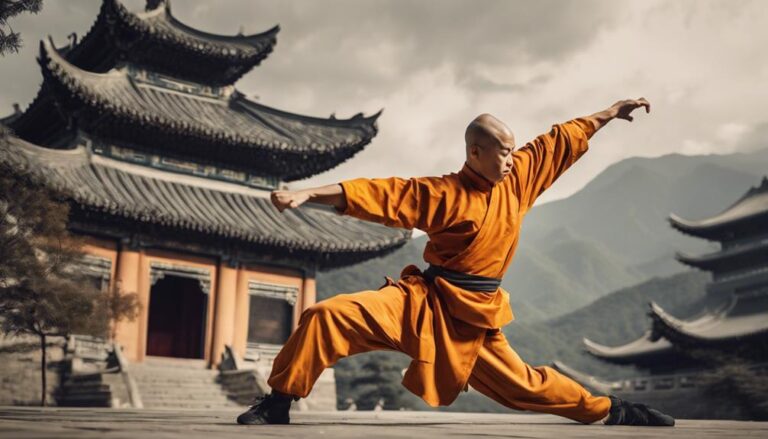You’ve probably heard of some, like Bruce Lee, whose innovative techniques revolutionized martial arts, or Ip Man, whose mentorship paved the way for Wing Chun’s global presence.
Yet, each master on this list has a unique story that has not only shaped the world of Kung Fu but also left an indelible mark on history. Discovering their journeys might just change your perspective on the art itself.
Contents
Bodhidharma: The Founder
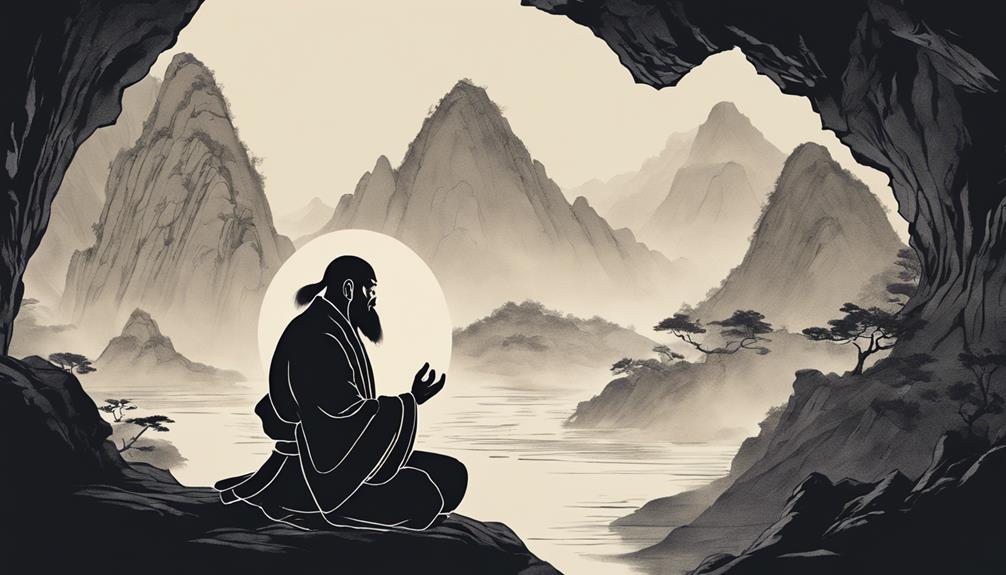
Bodhidharma, the Indian monk revered as the progenitor of Chan Buddhism, fundamentally transformed the Shaolin Temple by introducing martial arts as a medium for physical and spiritual cultivation in the 6th century.
His journey from India to China marked a pivotal moment in the history of martial arts, as he imparted innovative physical and mental training methods to the monks.
These practices not only enhanced their health and self-defense capabilities but also laid the groundwork for the development of Shaolin Kung Fu. This martial arts discipline, characterized by its emphasis on discipline, focus, and inner strength, traces its origins back to Bodhidharma’s teachings.
His legendary meditation facing a cave wall for nine years is often cited as the catalyst for the Iron Shirt technique, illustrating his profound influence on the Shaolin Temple and the evolution of martial arts.
Wong Fei-hung: The Hero
Moving from the foundational efforts of Bodhidharma, we now focus on Wong Fei-hung, a martial artist whose profound impact on Hung Ga Kung Fu showcases the evolution of Chinese martial arts into a symbol of cultural identity and moral integrity.
Wong Fei-hung’s contributions include:
- Mastering and innovating Hung Ga Kung Fu, enhancing its techniques and philosophies.
- Upholding moral values such as loyalty and righteousness, embodying the spirit of Chinese martial arts.
- Training numerous disciples, ensuring the transmission of knowledge and skills across generations.
- Leaving a cultural legacy, with his life and achievements inspiring a multitude of films, books, and cultural references.
His life’s work not only advanced Hung Ga Kung Fu but also solidified its place in the broader narrative of Chinese martial arts history.
Ip Man: The Mentor
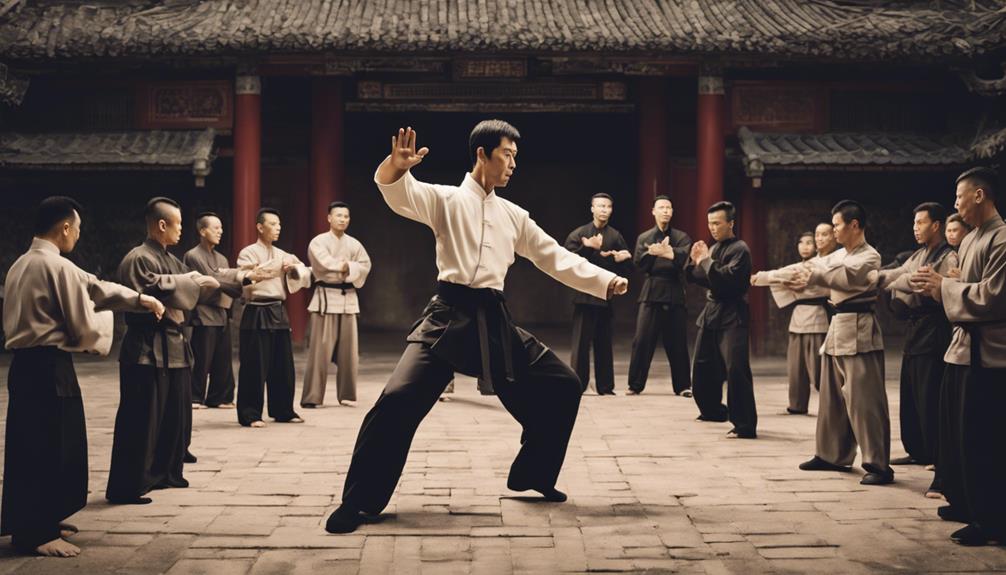
Within the annals of martial arts history, Yip Man emerges as a pivotal figure, renowned for his mastery and dissemination of Wing Chun, a discipline that he not only perfected but also popularized through his distinguished tutelage, including that of Bruce Lee.
Born in 1893, Yip Man’s establishment of the first Wing Chun school marked a seminal moment in the martial arts world, significantly elevating the profile of this fighting style well before his demise in 1972.
His profound skill, wisdom, and dedication to the art form’s preservation and promotion underscored his legacy, making him an indelible influence on the martial arts community. Through his mentorship, Yip Man didn’t just teach techniques; he imbued his students, most notably Bruce Lee, with a philosophy that continues to inspire and shape future generations of Wing Chun practitioners.
Bruce Lee: The Innovator
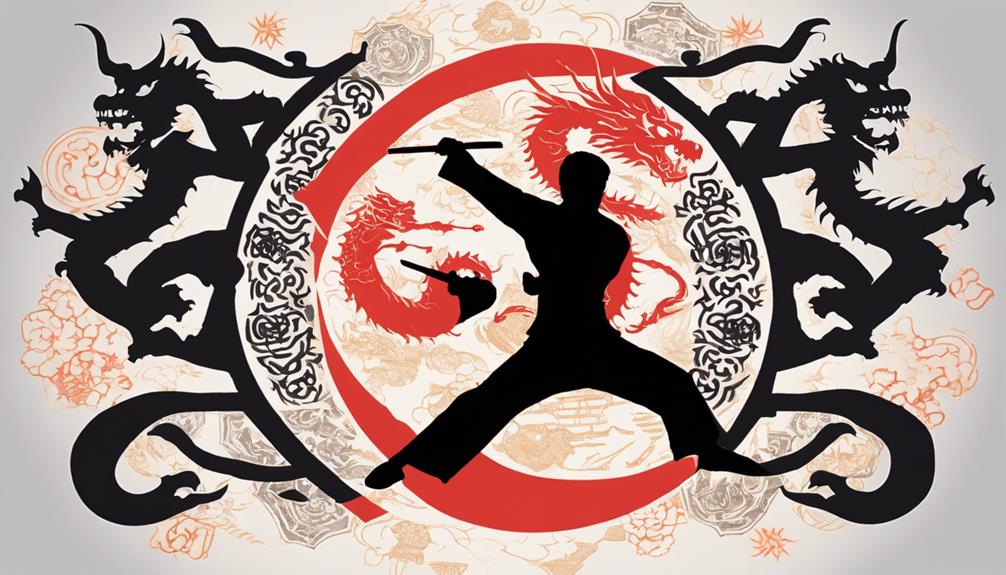
You’ve learned about Ip Man’s profound influence; now, you’ll explore how Bruce Lee revolutionized martial arts with his Jeet Kune Do philosophy.
This innovative approach emphasized practicality and adaptability, setting a new standard in global martial arts practices.
As you examine Bruce Lee’s legacy, consider how his methodologies and cinematic achievements have perpetuated his influence across disciplines worldwide.
Jeet Kune Do Philosophy
Through the lens of Jeet Kune Do, Bruce Lee not only founded a martial arts philosophy but also redefined the parameters of traditional combat practices with his emphasis on simplicity, directness, and practical utility. Jeet Kune Do, as conceptualized by Bruce Lee, stands as a testament to the power of adaptability and the pursuit of personal expression within martial arts.
Key aspects of Jeet Kune Do include:
- Simplicity: Stripping away the non-essential to focus on what’s truly effective in combat.
- Directness: Prioritizing the most straightforward path to achieving a goal in fighting.
- Practicality: Emphasizing techniques that are effective in real-world scenarios.
- Adaptability: Encouraging fluidity and the incorporation of diverse techniques to meet the demands of any combat situation.
Bruce Lee’s innovative approach challenges practitioners to continually evolve, making Jeet Kune Do a dynamic and enduring legacy in the martial arts world.
Global Martial Arts Influence
Bruce Lee’s innovative fusion of martial arts styles not only transformed the landscape of combat practices but also established a global legacy that continues to influence martial artists around the world.
By blending various disciplines to create Jeet Kune Do, Lee revolutionized martial arts, emphasizing efficiency, directness, and simplicity. His unparalleled physical abilities and mastery of techniques set a new standard for speed and agility among Kung Fu Masters and martial artists alike.
Through iconic films like ‘Enter the Dragon’ and ‘Fist of Fury,’ he popularized martial arts in Hollywood, bringing Eastern combat philosophies to a global audience. Lee’s teachings encourage martial artists to explore personal expression and innovation, ensuring his legacy endures as a beacon for those seeking to push the boundaries of martial arts training.
Zhang Sanfeng: The Mystic
You must appreciate Zhang Sanfeng’s innovative spirit in martial arts, particularly his creation of Tai Chi, which stemmed from an insightful observation of nature’s inherent dualism.
His philosophical beliefs, deeply rooted in Daoist principles, emphasized harmony between the body and mind, leading to the development of internal martial arts focused on cultivating Qi.
This holistic approach not only revolutionized martial arts but also offered a spiritual pathway, underscoring the interconnectedness of physical health and mental well-being.
Origin of Tai Chi
In the annals of Chinese martial arts, Zhang Sanfeng emerges as a pivotal figure, credited with the creation of Tai Chi (Tai Ji Quan), a discipline that redefines the nexus between martial prowess and meditative depth. Your exploration into Tai Chi begins with understanding its origins:
- Inspiration from Nature: The genesis of Tai Chi lies in an epiphany Zhang Sanfeng had after witnessing a confrontation between a snake and a crane, embodying the fluidity and adaptiveness that characterize Tai Chi movements.
- Promotion of Balance: Tai Chi’s slow, deliberate motions are designed to enhance balance and flexibility.
- Cultivation of Qi: Central to Zhang Sanfeng’s teachings is the cultivation of qi, fostering an internal energy that harmonizes mind and body.
- Global Recognition: Today, Tai Chi is celebrated worldwide, valued for its health benefits and its emphasis on internal strength and relaxation.
Philosophical Beliefs
Zhang Sanfeng’s philosophical contributions to martial arts, rooted in the fusion of Taoist principles with combat techniques, represent a seminal shift towards the internal cultivation of strength and harmony. His approach underscored the importance of integrating the mind, body, and spirit to achieve a state of equilibrium, embodying the essence of Yin and Yang balance.
This holistic perspective catalyzed the evolution of internal martial arts, notably Tai Chi and Xin Yi Quan, emphasizing fluidity, adaptability, and the harnessing of Qi for enhanced health, longevity, and martial effectiveness.
| Principle | Impact | Martial Art |
|---|---|---|
| Internal Energy (Qi) | Health & Longevity | Tai Chi |
| Harmony with Nature | Spiritual Growth | Xin Yi Quan |
| Yin and Yang Balance | Inner Strength | Internal Style |
Huo Yuanjia: The Patriot
Huo Yuanjia, a legendary martial artist, fundamentally transformed the landscape of Chinese martial arts through his establishment of the Chin Woo Athletic Association, emphasizing the intertwining of national pride and cultural identity in martial arts practice. You’ll find his story resonates deeply with themes of resilience and patriotism, demonstrated through:
- His notable victories against foreign fighters served as a symbol of national strength.
- The foundation of the Chin Woo Athletic Association promotes traditional Chinese martial arts worldwide.
- Inspiring the film ‘Fearless’, with Jet Li portraying his life, thereby immortalizing his legacy in popular culture.
- Continuation of his legacy through Chin Woo schools globally, which uphold his vision of martial arts intertwined with cultural pride.
Analyzing Huo Yuanjia’s contributions offers a profound insight into the role of martial arts in fostering national identity and international respect.
Chen Fake: The Reformer
Shifting our focus to another monumental figure in martial arts history, let’s examine Chen Fake, whose groundbreaking work in Chen-style Tai Chi reshaped this ancient practice for generations to come.
As the grandson of the esteemed Tai Chi master Chen Changxing, Chen Fake not only continued his family’s legacy but also significantly refined and popularized Chen-style Tai Chi.
His teachings, deeply rooted in the principles of relaxation, internal power cultivation, and martial applications, attracted numerous disciples, thereby extending the lineage across China and influencing Tai Chi’s modern global practice.
Chen Fake’s lasting legacy is his preservation and advancement of traditional Tai Chi principles, techniques, and forms, ensuring their relevance for future generations of martial artists.
Conclusion
In summary, it’s evident that these seven legendary Kung Fu masters have indelibly shaped martial arts. From Bodhidharma’s foundational teachings to Chen Fake’s reformative practices, their contributions range from innovative techniques to philosophical underpinnings.
This rich legacy transcends mere physical prowess, underscoring a profound cultural heritage that marks its enduring influence on both martial arts and global culture.
Analyzing their diverse yet interconnected impacts reveals the depth and breadth of Kung Fu’s evolution. This historical tapestry highlights not just martial excellence but also a profound cultural heritage.
